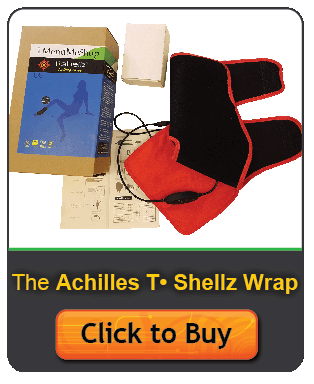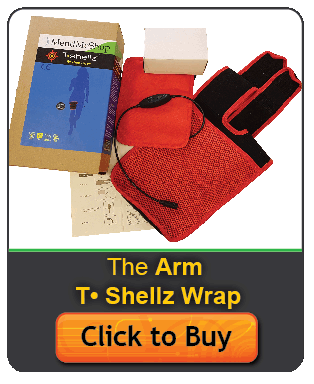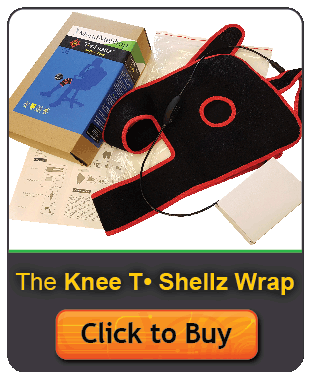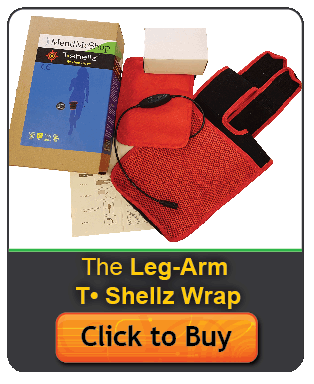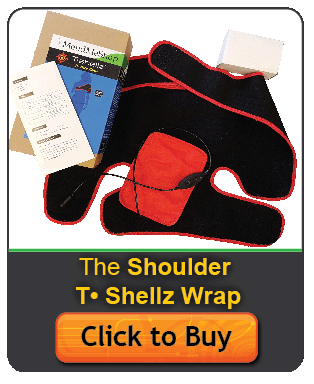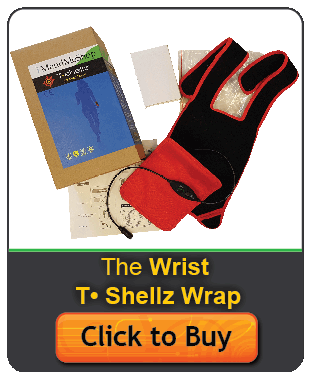|
More Tendon Facts:
Tenosynovitis is a condition affecting the sheath that surrounds a tendon. In many cases, the sheath encounters tearing due to inflammation of the underlying tendon. The majority of tenosynovitis sufferers are female.
A fully ruptured Tendon REQUIRES surgery. It will not heal on its own.
Except for a fully ruptured tendon, Tendonitis can almost always be cured without surgery.
Left untreated, tendonitis can be extremely debilitating and lead to life long complications.
Continually using your Tendon while it is injured will lead to a worse injury.
To Heal as fast as possible use conservative treatment options at home such as: Rest
Use an Ice Pack to Get Swelling Down
Use a TShellz Wrap at Home Once Swelling is Down
Stretch at Home Once Your PT or Doctor Approves
Treat the Injury Well Beyond the Point After the Pain Disappears
| Stopping the Cycle of Repetitive Strain Injuries
How to Use Superior Home Treatments to
Heal & Relieve Pain from Repetitive Strain Injuries (RSI)!
If you're suffering from a repetitive strain injury you've probably had to face the frustration of managing your pain for weeks, months or even years. Sometimes even when you think it's been dealt with (and healed) you'll wind up with the same pain months or years later.
When you have a repetitive strain injury you'll always be at risk of suffering from the same injury over and over again. This is because any injury caused by repetitive activity or placement of your fingers, hands, wrists, elbows, arms, shoulders, back, hips, legs or feet is based on a long-term pattern of the way you move. This activity is triggered by movement that's on-going in your life - like a 9 to 5 desk job with extensive computer work, picking and packing parcels for 8 to 12 hours per day, or even operating heavy duty (vibrating) machinery regularly.
There are only 2 ways you can deal with the chronic pain once and for all:
- Permanently stop the activities causing your injury (and any other related activities that could make this injury comeback).
OR
- Work with the activity by treating your injury on a continuous basis with conservative treatment methods and adjusting your posture, workspace or technique.
Surgery is also another thing to think about, but having a surgical procedure will end up forcing you to choose 1 of those options in the end. Even after the surgery is done, you'll be returning to your job or activities that caused the injury in the first place.
Without proper care and attention you'll wind up with the same injury all over again. It may take months or years but it'll still happen. And that's because you haven't made the choice to stop the cycle of repetitive use OR adjust your activities and treatment.
If you've gotten this injury from your job you're probably thinking to yourself:
"I'm not quitting my job... I have bills to pay!"
If this is a condition from an activity you love (like playing music, gardening, designing, painting, etc.) then you're probably asking yourself:
"Do I really need to give up the things I love to do?"
You don't have to make these sacrifices to live a full, happy and healthy life. If you choose not to give these things up then you're automatically deciding to go for option 2. This means continuously treating your condition with conservative treatment methods and adjusting your activities.
Even though this sounds complicated it's actually surprisingly easy. Thousands of people are already treating themselves in ways to avoid surgery or live off of pain medications. Why should a repetitive strain injury be any different?
This is as simple as making sure that your have proper blood flow circulation while healing your injury. You can even maintain good health in that area with continued Circulation Boost (Circulatory Boost) treatments. If you're suffering from on-going pain, inflammation or swelling in the area, then consistent treatment with cold compression is a very effective way to manage those symptoms. Adjusting your activity will only ever really involve taking a good look at your posture, workspace and technique.
Fortunately for you there are tools available to help you do all of these things!
Using Circulation Boost and cold compression to treat repetitive strain injuries is nothing new. Professional athletes have had access to state of the art treatments for years that allow them to heal more quickly and completely than you or I. This is why athletes that have repetitive strain injuries can often get back in the game in a matter of weeks while you could suffer for months or even years.
If you want to be proactive about properly dealing with your repetitive strain injury, speak to your doctor about adding AidYourTendon's system utilizing Circulatory Boost and cold to round out your treatment.
What is a Repetitive Stress?
Repetitive Stress, also referred to as Repetitive Strain Injury, is an injury or multiple injuries to the nervous system and musculoskeletal structure caused by repetitive use of one or more muscles and joints in the body. It happens when you perform the same action over and over again.
It is a general term that refers to many conditions including (but not limited to) Carpal Tunnel Syndrome, de Quervain's Disease, Writer's Cramp, Vibration Induced White Finger, Radial Tunnel Syndrome, bursitis, tendinitis (tendonitis), tenosynovitis, and trigger finger.
A repetitive stress injury usually occurs after the age of 30 and is a result of wear and tear from the overuse of muscles, tendons, joints and ligaments as you age. These repetitive motion injuries can occur in the shoulders, back, neck, hands, hips, wrists, elbows and lower limbs.
Repetitive strain injury (RSI) is very common and is referred to by other names including: repetitive stress injury, repetitive motion injury, repetitive motion disorder (RMD), cumulative trauma disorder (CT), occupational overuse syndrome, overuse syndrome, regional musculoskeletal disorder, and work related upper limb disorder (WRULD, ULD).
All forms of repetitive stress injuries are painful and uncomfortable with damage occurring in your muscles, tendons, nerves and/or other soft tissues.
What are the Symptoms of a Repetitive Stress Injury?
You may experience some of these symptoms depending on the area of your body that's affected by a repetitive strain injury (RSI):
- Tenderness, swelling, and redness in the affected muscle or joint.
- Pain when you move the area that may cause you to wake throughout the night.
- Stiffness in the affected muscles, tendons, joints and bones.
- A throbbing (pulsating) sensation in the affected area
- Pins and needles (tingling) in the affected area, especially the hand or arm
- Loss of sensation (numbness) in the hand of the affected limb
- Loss of strength in the muscle
- Discomfort brought on by a particular task that improves when it is stopped - i.e., when pain lessens or disappears over weekends or during holidays away from work.
Your symptoms may tend to develop slowly over time and only occur when you're doing the repetitive task. These symptoms may also seem to get better or decrease with rest. The pain can range from mild to severe, as time goes on you may notice the pain is present all the time and gets worse by doing the repetitive task or activity that's caused your injury.
What Causes a Repetitive Stress/Strain Injury?
It's possible for some people to develop repetitive strain while others won't even when doing the same tasks for similar periods of time. The reason is not clear as to why you can develop this condition. What is known is that daily repetitive movements (typically longer than 2 hours per day) involving the work in a factory (soldering or assembling pieces), office (typing or clicking a mouse), or warehouse (lifting or twisting) can lead to RSI.
Some other causes of this condition include:
- Having poor posture while working at a desk or awkward positioning while performing tasks such as shoveling, sliding, lifting, and twisting.
- Heavy loads and forceful exertion on the soft tissue (bursae, muscles, tendons, joints, and ligaments) that cause trauma or fatigue.
- Frequent vibrations that cause blood vessels to constrict and impair circulation.
- Daily repetitive movements (usually longer than 2 hours per day) usually involved with working in a factory (sorting or assembling pieces), office (typing or clicking a mouse), or warehouse (lifting or twisting).
- Failing to rest the affected area or missing break periods needed periodically while performing repetitive movements (activities or at work).
- Repeating the same movement during a sport or leisure activity such as gardening.
Examples of Repetitive Strain Injury
- Housemaid's Knee (pre-patellar bursitis) - long periods of time kneeling to tile or scrub a floor
- Biceps tendinitis (tendonitis) - repeated scrubbing motion
- De Quervain's Disease - repeated twisting of the wrist or pinching motions
- Tennis elbow (lateral epicondylitis) - forceful backward bending of the wrist when painting with a brush
- Golfer's elbow (medial epicondylitis) - forceful forward or twisting motion of the wrist when pulling on ropes
RSI Treatments - What You Can Do!
If a Repetitive Stress is detected early, there is a greater chance that the condition can be reversed and symptoms can be eased.
If you have been diagnosed with RSI, it is recommended that you rest the injured body part from any aggravating factors, especially the task(s) that caused the condition. Your physician will probably recommend conservative treatments such as painkillers/anti-inflammatories, physio, rest and icing of the injury. In cases where conservative treatments are recommended, talk with your physician or PT about incorporating TShellz Wrap® treatments into your at-home treatment regimen. Read more about treatments here.
1
What Type of Repetitive Strain Injury (RSI)
Do You Have?
Neck Injuries
- Cervical Spondylosis - osteoarthritis that affects your neck. Pressure from carrying heavy load on your head on a regular basis, driving for long hours on a daily basis or working for long hours daily hunched over a computer. Encourages the natural degeneration of the spine bones.
Shoulder Injuries
- Adhesive Capsulitis (Frozen Shoulder) - using a computer with poor posture and incorrect ergonomics of the workstation. Over-time misalignment of your back, shoulder blade and upper arm puts more stress on the ligaments and tendons around your shoulder.
- Rotator Cuff Syndrome - Holding a phone receiver between your cheek and shoulder, incorrect posture and work station putting stress on the shoulder area, overloading backpack or laptop bag with too many heavy items. Overworking or extra stress to the tendon causes micro-tearing to a tendon tissue. Rotator Cuff Syndrome also includes shoulder Bursitis (Subacromial), Rotator Cuff Tendonitis and Impingement Syndrome
- Biceps tendinitis (tendonitis) - repeated scrubbing motion. The overuse of the tendon cause small micro-tearing to a tendon tissue.
Elbow / Arm Injuries
- Tennis elbow (lateral epicondylitis) - forceful backward bending of the wrist when painting with a brush. Computers users, 'mouse elbow' or laptop touchpad users. The consistent pressure with the hand and fingers cause small micro-tearing to a tendon at the elbow.
- Cubital Tunnel Syndrome (medial epicondylitis) - pressure applied over a long period of time to the ulnar nerve in the elbow, such as leaning your arm against a table on the inner part of your elbow or repetitive movements of the arm bending and straightening with or without heavy items.
Wrist / Hand Injuries
- De Quervain's Disease - repeated twisting of the wrist or pinching motions. The repetitive movement of the fingers and thumb with or without weight, causes micro-tearing to a tendon.
- Trigger Finger / Thumb - repetitive use of hand, in where you are gripping on power tool, hammer or broom too tightly. Causes damage to the tendon and nodules form restricting the movement of the tendon and pulls the finger into a locked position.
- Carpal Tunnel Syndrome (CTS) - is a name for a group of wrist related problems, Computer users,mobile phoneusers, PDA users. Many activities / hobbies involving repetitive hand movements, awkward hand positions, strong gripping or vibration - like sewing, knitting, and gardening, tailor, production sewer, farmer, assembly-line worker, mechanic, gardener, painter, office worker, cashier, and butcher. The tendon sheath becomes inflamed and swells trapping the tendons and nerves in the wrist. CTS cause pain, range of motion loss and in some people loss of feeling.
- Cramp of the Hand (Writers' Cramp) - over-use of the hand and/or gripping a pen too hard.
- Vibration-induced White Finger - a cumulative condition related to the use of hand-held power tools.
Knee Injuries
- Housemaid's Knee (pre-patellar bursitis) - long periods of time kneeling to tile or scrub a floor. Pressure on the bursa causes the fluid filled bursa sac to become inflamed swollen and very painful.
Injuries that can Affect any Area in the Body
- Bursitis - all joints in the body have a bursa sac, to provide lubrication, direct pressure to the surround area. The bursa becomes inflamed, swollen and very painful.
- Ganglion Cyst - The cyst is basically a soft sac filled with a thick, clear fluid. Cysts most commonly show up in the wrist, hand, ankle, feet and near other joints. The cyst enlarges may or may not cause pain, but can cause range of motion loss if the cyst becomes too large.
- Tendinitis - damage and/or micro-tearing to a tendon (closest to bone), to much force on the tendon (lifting heavy items) or push pull action to the tendon (swing a golf club).
- Peritendinitis - similar to tendonitis, but it's damage and/or micro-tearing to a tendon closest to the connection point to muscle.
- Tenosynovitis - damage, micro-tearing and/or inflammation of the sheath covering your tendon.
Product Advisors are available 9:00 am to 5:00 pm Eastern Standard Time Monday to Friday.
Learn More About Tendon Injuries & TreatmentsI want to learn more about Post-Surgery Recovery I want to learn more about TShellz Wrap® Circulatory Boost I want to learn more about Ice & Heat: Which Is Better For Treatment? I want to learn more about Tendonitis Treatments I want to learn more about Tendonitis Surgery
FREE SHIPPING ON ALL PRODUCTS CURRENTLY ENABLED
60 DAY TRIAL PERIOD
During your recovery, you will probably have to modify and/or eliminate any activities that cause pain or discomfort at the location of your soft tissue injury until the pain and inflammation settle. The more diligent you are with your treatment and rehabilitation, the faster you will see successful results!
|
Tendon Injury Facts:
When the tendon gets inflamed it is known as tendonitis, and when the tendons are chronically overused, it may lead to microscopic tears in the collagen matrix and causes a gradual weakening of the tissues.
Achilles tendonitis is a common injury among runners, as the Achilles tendon is responsible for helping you lift off the ground with each stride.
As computers become ever more important elements of the work place and everyday life, incidents of wrist tendonitis are on the rise.
Oral Medications can mask the pain but do not aid in the healing of tendonitis. Anti-inflammatories and pain killers can mask the pain and indirectly cause tendonitis to worsen.
Ice and Compression treatments are the easiest and most effective treatments for tendonitis.

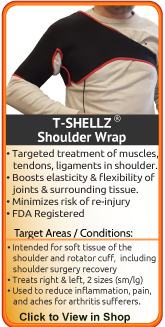




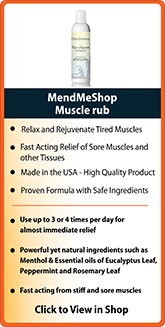

|





















